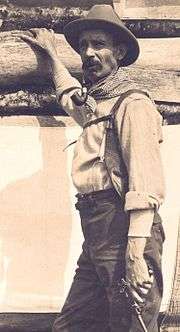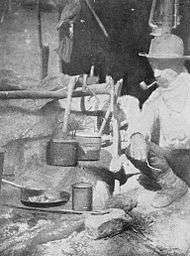Horace Kephart
Horace Sowers Kephart (September 8, 1862 – April 2, 1931) was an American travel writer and librarian, best known as the author of Our Southern Highlanders about his life in the Great Smoky Mountains of western North Carolina and the classic outdoors guide Camping and Woodcraft.
Horace Kephart | |
|---|---|
 Kephart in 1906 | |
| Born | September 8, 1862 East Salem, Pennsylvania, United States |
| Died | April 2, 1931 (aged 68) Bryson City, North Carolina, United States |
| Resting place | Bryson City Cemetery Bryson City, North Carolina[1] |
| Occupation | Librarian |
| Nationality | American |
| Education | Lebanon Valley College, Boston University, Cornell University[2] |
| Genre | Outdoor literature, Travel literature |
| Spouse | Laura (Mack) Kephart[3] |
Biography
Kephart was born in East Salem, Pennsylvania, and raised in Iowa. He was the director of the St. Louis Mercantile Library in St. Louis, Missouri from 1890 to 1903. In these years Kephart also wrote about camping and hunting trips.[4] Earlier, Kephart had also worked as a librarian at Yale University and spent significant time in Italy as an employee of a wealthy American book collector.
In 1904, Kephart's family (wife Laura and their six children) moved to Ithaca, New York, without him, but Laura and Horace never divorced or legally separated. Horace Kephart found his way to western North Carolina, where he lived in the Hazel Creek section of what would later become the Great Smoky Mountains National Park:
I took a topographic map and picked out on it, by means of the contour lines and the blank space showing no settlement, what seemed to be the wildest part of these regions; and there I went.[5]
Later in life Kephart campaigned for the establishment of a national park in the Great Smoky Mountains with photographer and friend George Masa, and lived long enough to know that the park would be created. He was later named one of the fathers of the national park. He also helped plot the route of the Appalachian Trail through the Smokies.[6] Kephart died in a car accident in 1931, and was buried near Bryson City, North Carolina, a small town near the area he wrote about in Our Southern Highlanders.[7] Two months before his death, Mount Kephart was named in his honor.[4]
The Mountain Heritage Center and Special Collections at Hunter Library, Western Carolina University have created a digitized online exhibit called "Revealing an Enigma" that focuses on Horace Kephart's life and works. This exhibit contains documents and artifacts (photos and maps) that can be browsed or searched.
Ken Burns' multi-part documentary, The National Parks: America's Best Idea, features Horace Kephart in the fourth episode (1920–1933), which was initially broadcast on September 30, 2009.
Kephart is a character in Ron Rash's novel Serena, as well as Walt Larimore's novels, Hazel Creek and Sugar Fork.
Writings

He wrote of his experiences in a series of articles in the magazine Field and Stream. These articles were collected into his first book, Camping and Woodcraft, which was first published in 1906.[8][9] While mostly a manual of living outdoors, Kephart interspersed his philosophy:
Your thoroughbred camper likes not the attentions of a landlord, nor will he suffer himself to be rooted to the soil by cares of ownership or lease. It is not possession of the land, but of the landscape, that enjoys; and as for that, all the wild parts of the earth are his, by a title that carries with it no obligation but that he shall not desecrate nor lay them waste. Houses, to such a one, in summer are little better than cages; fences and walls are his abomination; plowed fields are only so many patches of torn and tormented earth. The sleek comeliness of pasture it too prim and artificial, domestic cattle have a meek and ignoble bearing, fields of grain are monotonous to his eyes, which turn for relief to abandoned old-field, overgrown with thicket, that still harbors some the shy children of the wild. It is not the clearing but the unfenced wilderness that is the camper's real home. He is brother to that good old friend of mine who in gentle satire of our formal gardens and close- cropped lawns, was wont to say, 'I love the unimproved works of God.'[10]
He also published some more books of the same theme such as Camp Cookery (1910) and Sporting Firearms (1912). In addition, he wrote The Hunting Rifle section of Guns, Ammunition and Tackle (New York: Macmillan, 1904), a volume of Caspar Whitney's prestigious American Sportsman's Library.[11]
Combining his own experience and observations with other written studies, Kephart wrote a study of Appalachian lifestyles and culture called Our Southern Highlanders, published in 1913 and expanded in 1922.[4][12]
He wrote a short history of the Cherokee[13] and other books which became standards in the field.[6]
Kephart completed a typescript for a novel in 1929. However, the book was not edited and published until 2009, when it was published under the title Smoky Mountain Magic by Great Smoky Mountains Association.[14]
Kephart never left the Great Smokies, having been instantaneously killed in a mountain-road automobile accident on April 2, 1931.
See also
References
- Horace Sowers Kephart at Find a Grave
- Finding Aid for the Jim Casada Collection of Horace Kephart and George Masa MS.3452, University of Tennessee Special Collections Library finding aid. Retrieved: 4 October 2013.
- George Lowery, "Outdoor Legend Horace Kephart's Many Cornell Roots," Cornell Chronicle, 11 October 2011. Retrieved: 4 October 2013.
- "Horace Kephart: Biography". Horace Kephart: Revealing an Enigma. Hunter Library Special Collections, Western Carolina University. Archived from the original on June 3, 2011. Retrieved 2006-06-24.
- Frome, Michael (1994). Strangers in high places: the story of the Great Smoky Mountains. Knoxville: University of Tennessee Press. ISBN 0-87049-806-1.
- http://findarticles.com/p/articles/mi_6759/is_30/ai_n28413324/ Horace Kephart and Thomas Wolfe's "abomination," Look Homeward, Angel, Thomas Wolfe Review - 2006
- "Archived copy". Archived from the original on 2006-12-18. Retrieved 2007-04-02.CS1 maint: archived copy as title (link) A hike with a bit of history, The Smoky Mountain News - 13 July 2005
- Kephart, Horace (1906). Camping and Woodcraft: A Handbook for Vacation Campers and for Travelers in the Wilderness. Univ of Tennessee Pr. LCC SK601 .K3.
- Kephart, Horace (1988). Camping and Woodcraft: A Handbook for Vacation Campers and for Travelers in the Wilderness. Univ of Tennessee Pr. ISBN 0-87049-551-8.
- (page 21)
- "Hunting Rifle by Horace Kephart". Guns, Ammunition and Tackle. 1904.
- Kephart, Horace (1922). Our Southern Highlanders; a Narrative of Adventure in the Southern Appalachians and a Study of the Life Among the Mountaineers, by Horace Kephart. New York: The Macmillan Company. LCCN 22021761. LCC F210 .K382.
- Kephart, Horace (1936). The Cherokees of the Smoky mountains;. Ithaca, N.Y.: The Atkinson press. LCCN 36019280. LCC E99.C5 K4.
- Horace Kephart (2009). Smoky Mountain Magic. Gatlinburg, TN: Great Smoky Mountains Association. ISBN 0937207659. OCLC Number:462873637, Description:xl, 205 pages,1 illustration, map; 24 cm; Responsibility:Horace Kephart, with an introduction by George Ellison and foreword by Libby Kephart Hargrave; Publisher description: "When a mysterious (though familiar looking) stranger arrives on Deep Creek, he immediately encounters a vast cadre of characters that includes earnest mountaineers, a murderous land baron, a family of treacherous ne'er-do-wells, a beautiful botanist, a Cherokee Indian chief, and a witch. A search for hidden treasures leads a community to erupt into violence while the hero comes to realize that what he truly seeks may be more animal than mineral"
External links
| Wikimedia Commons has media related to Horace Kephart. |
- Works by Horace Kephart at Project Gutenberg
- Works by Horace Kephart at LibriVox (public domain audiobooks)

- Works by or about Horace Kephart at Internet Archive
- Horace Kephart: Revealing an Enigma (from Hunter Library Special Collections, Western Carolina University)
- Camping and woodcraft; a handbook for vacation campers and for travelers in the wilderness (1921)
- Camping And Woodcraft(1917) | by Horace Kephart, The Macmillan Company
- Sporting Firearms(1912)| by Horace Kephart, Outing Publishing Company
- Camp Cookery(1910) | by Horace Kephart, Outing Publishing Company
- Horace Kephart at Find a Grave